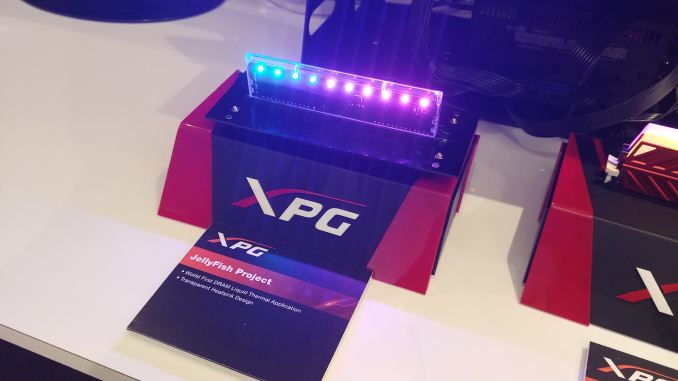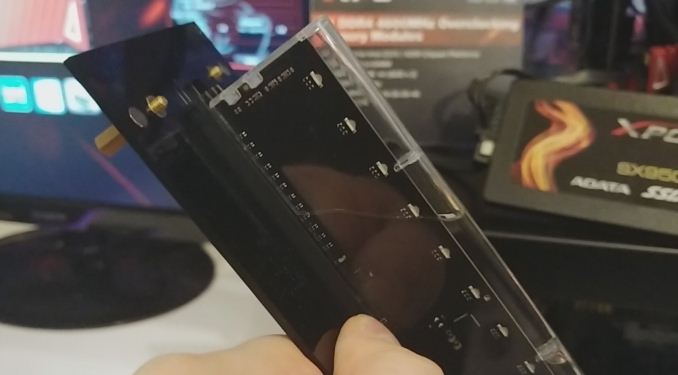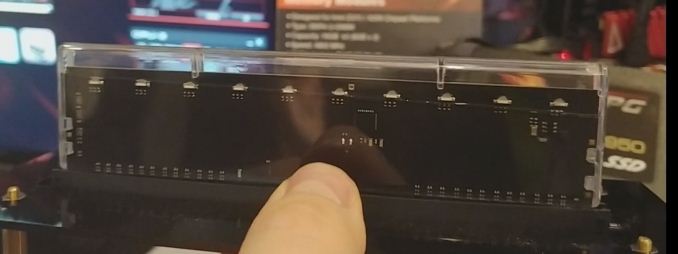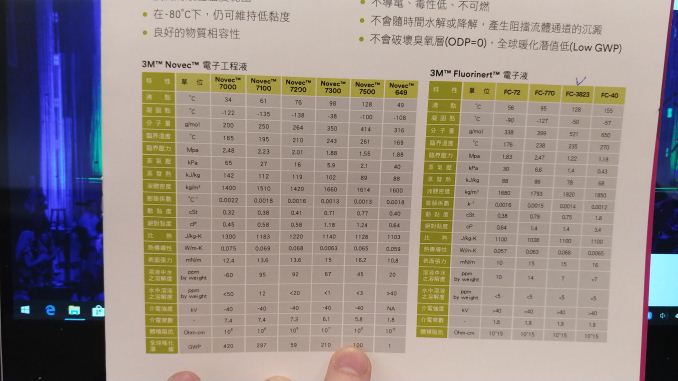ADATA at CES 2018: Jellyfish DRAM
by Ian Cutress on January 16, 2018 8:00 AM EST- Posted in
- Memory
- ADATA
- DDR4
- Trade Shows
- Liquid Cooling
- DRAM
- 3M
- CES 2018
- Jellyfish
- Novec
- Fluorinert

LAS VEGAS, NV – Over the years, DRAM heatsinks have gone from non-existent, to gaudy, to death traps with jagged edges, to some form of LED hell. In the middle we saw some DRAM vendors produce modules for water cooling with pre-applied water cooling pipes and heatsinks, but these were not overly popular. ADATA thinks they have the next step in DRAM cooling technology.
The concept of these ‘Jellyfish’ modules is that by using a sealed and clear plastic case around the memory chips, the case can be filled with a non-conductive liquid, such as 3M Novec/Fluorinert that we have seen in custom PCs and server cooling. These chemicals, basically long chain hydrocarbons with funny bits on the end, are liquid at room temperature but can eventually change state into a gas and rise. That state change can absorb a lot of energy being produced, and as long as the energy is removed and the chemicals become liquid again by cooling down, the liquid forms a convection current and in essence, a heat pump. Even if the chemical does not change state from liquid to gas, with the right viscocity, warm liquid will also cause a convection current.
So cue ADATA’s Jellyfish: bare DRAM modules, in a plastic case, with about a spoonful of 3M Fluorinert. The modules also have a dozen LEDs for good measure.
Normally this 3M liquid is not cheap: over 10 years ago, when enthusiasts realized that mineral oil PCs were more hassle than they were worth, a number of people experimented at a cost of $300 per gallon (they didn’t state US or UK gallon). According to ADATA, the 3M liquid is now about $100 per litre. If you want to do the conversion, it means it is more expensive today than it used to be. A spoonful of this stuff, per module, will still add some cost to a build. But as a prototype, it is certainly an interesting change from all the LED DRAM we see out there.
One caveat, which ADATA noted, is that the prototype was not completely filled. This would mean that when placed vertically in a case, a couple of DRAM chips would not be covered. Jellyfish is still in its early stages of development, so if it ever comes to retail, there might be some changes. ADATA stated that due to the design, they have a patent on this technology, so it will be interesting to see if anything can come from that.
Related Reading
- ADATA Unveils New XPG RGB DDR4 Kits
- ADATA Announces XPG Storm: A Cooler for M.2 SSDs with a 16500 RPM Fan
- ADATA Premier and XPG SDXC and microSDXC Cards Review
















18 Comments
View All Comments
prtskg - Wednesday, January 17, 2018 - link
+1Valantar - Tuesday, January 16, 2018 - link
Have to love this. Given that RAM doesn't actually need heatsinks outside of extreme OC scenarios (in which direct airflow without a heatsink is still usually sufficient, and a heatsink without direct airflow usually isn't), this is beyond silly. Given that it's plastic, it won't dissipate heat at any real rate (and probably won't cool much at all once you reach heat soak, which won't be far out given the plastic casing and small amount of liquid), and given thermal fluctuations the plastic and/or seals will inevitably crack and the goop will leak all over your motherboard. This probably won't matter much, given that it's non-conductive, but I really, really, REALLY struggle to see the point.abrowne1993 - Tuesday, January 16, 2018 - link
"The modules also have a dozen LEDs for good measure."Oh well thank goodness they didn't forget that.
Dragonstongue - Tuesday, January 16, 2018 - link
way back when with higher voltage dram I could maybe understand cause they for sure pushed out heat, but modern ram even running high clock speed barely get warm to the touch given the low voltages and lower nm die design.Bling is the new rage, from cases that do not have effective airflow to prioritize BOM for fancy lighting, to ram being filled with liquid cooling of various sorts to make sure it is kept cool, than you get the polar opposite with nvme style on motherboard ssd that use "heat shields" that for sure need to be kept cool to run at full speed instead are allowed to contain heat not wick it away thereby causing throttling and/or possibly reducing component lifetime.
As the saying goes, there is a a sucker born every minute
MrSpadge - Tuesday, January 16, 2018 - link
Voltage went down, but density & frequency went up. Overall power consumption of DRAM has not changed from "1 to few W" since a long time.Manch - Wednesday, January 17, 2018 - link
Wow so if US gallon it went from 79$ to 100 per liter so therefore a 26.5% increase.If imperial 66$ to 100 and that would be a 51% increase.
100$ now was equivalent to about 84$ 10 years ago adjusting for inflation its only 6% if US and 27% if imperial.
OK back to my WDS server hell mixed with a case of jet lag...
Chuck_NC - Wednesday, January 17, 2018 - link
As an engineer, I think this is great, although I think ADATA should market this better. To quote Steve Jobs: "It is not the consumer's responsibility to know what they want".The package keeps ESD away from the internal IC's, decreasing the out of box failures (although the PCB edge pins are still exposed), and the package is fine for most memory power dissipation needs. I hope they made the plastic out of ESD dissipated materials, or the pins will get zapped nearly 100% of the time during installation if you aren't using an ESD strap!
If overclocking, there are several easy improvements for thermal conductivity. The airspace inside the package can be easily mitigated (think thermal tabs or expansion bladders for the liquid), and the plastic package can be made fluted (inside and out) to increase surface area to get better heat transfer to the outside.
Overall, awesome concept.
DSGT_Crockett - Thursday, January 18, 2018 - link
IThis only has the effect of making me even more nervous trying to spec a system. If I'm ready to go away from air, I'm already accepting a huge portion of risk (yeah, yeah); to get to a point where an out-of-circuit "exotic-fill" self-contained (how heavy?) DIMM or four would make sense (absent inflated/doctored/cleverly-tinkered benches that might've followed if they sold this gimmick to someone with a bigger name than freakin' ADATA) as a risk, I'd need an awful lot of industry BS to justify even the consideration.